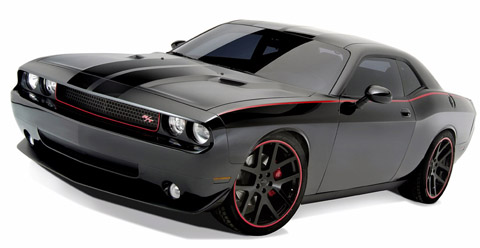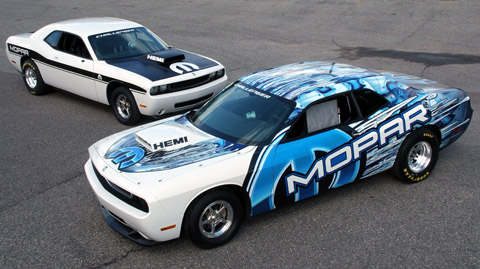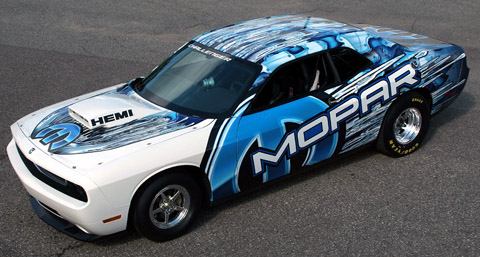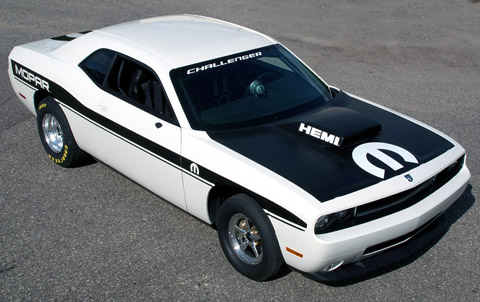The new Challenger is a pretty faithful, if 21st century replication of the famed 1970 Challenger, a car that was a member of the "pony car" class, named for the original pony car, Ford's Mustang, which came out in 1964. The cars were a big hit, beloved for their long hoods and truncated trunks. As the Sixties moved along, the cars got hotter, and by the end of the decade the Big Three -- Chrysler, GM and Ford -- were stuffing monster engines in cars that were still relatively small.
But the auto industry is nothing if not evolutionary, wedded to constant change as the handmaiden of marketing. Stay the same and you die. Change and you live, even thrive. Something, of course, went wrong over the past several years, and so we have now have the supreme irony of the Big Three -- two of which have tasted the bitter roots of bankruptcy -- turning out three really charged-up go-fast cars in an age when that is not exactly the soup du jour in the horribly bruised and nearly fractured auto-selling business.
Still, these hot coupes are out there, and the Challenger SRT8 is one hunk of attractive muscle -- and that's not really me saying it; it's the people who stopped me on the street, or rolled down their windows at a stoplight to ask about it. And what is it?
It's a two-door coupe whose design characteristics make you really feel as if you're in a 1970s version of this car. The windshield is smaller and more vertically oriented than the current vogue. The trunk has a high liftover -- back when the Challenger originated, the auto makers didn't realize that people don't want to lift a heavy suitcase over a high bridge of the car's rear end steel.
The inside has sumptuous leather bucket seats, but is otherwise pretty plain-spoken -- intentionally so, I think, given the car's orientation to performance. With a sop to current marketing demands, the SRT8 had all the mod cons we're used to -- navigation, super stereo, power everything, automatic trunk-lid opener -- but the main thrust of the car (so to speak) is performance. And that's where things like radios and power windows become superfluous.
First off, the six-speed stick shift is really worth it. I normally am not a fan of rowing a gear stick back and forth in urban traffic jams, but this one is so slick and, well, hot-roddy fun, that it didn't matter. (You can also get the five-speed automatic, but the manual tranny will make you think you're 10 years younger. Or something like that.)
Starting off, you will find that 425 horses in a two-ton coupe will move you down the road with alacrity. The engine has so much torque that you can easily skip a gear -- shift from first to third to fifth -- and you could tool around town all day using second and third.
In the hills, the SRT8 is not going to handle like a Porsche Boxster or Honda S2000, but that's not why you're driving it. The fun of this big hot rod is the overall sense of it -- you can hear those deep, throaty exhaust noises, you can feel that big engine rocking the car -- and the feeling of being in a new iteration of something that was a honking great auto experience some 40 years ago.
Of course, Chrysler is not alone in this revival of hotted-up pony cars -- Ford has its Mustang Shelby GT500 (5.4-liter, 540 horsepower) and Chevrolet has the Camaro SS (6.2-liter, 426 horsepower).
None of these cars is something designed for our current age of caution, this time of economic and resource turbulence and mild paranoia.
No, they're not making hybrid versions of the SRT8 now and for all we know, this car may be history a few years down the road, given the absolute shipwreck that is the U.S. auto industry these days.
So enjoy it while you can.
SPECIFICATIONS:
2009 Dodge Challenger SRT8; front engine, rear-wheel drive two-door coupe.
Price: test model, $45,525 (Base price: $39,820)
Power train: 6.1-liter V8 425-horsepower engine. Six-speed manual transmission.
Curb weight: 4,140 pounds.
Seating capacity: five.
Fuel consumption : 14 mpg, city; 22 mpg, highway.
Fuel tank capacity: 19 gallons.
Length: 197.7 inches; width: 75.7 inches; height: 57.1 inches; wheelbase: 116 inches.
Warranty: three years/36,000 miles.
Dependability: Dodge ranks 24th out of 37 brands (below industry average) on the J.D. Power and Associates 2009 Vehicle Dependability Study.
Safety: for vehicle safety ratings, visit the Insurance Institute for Highway Safety and the National Highway Traffic Safety Administration.
Source: Chrysler Group LLC; U.S. Environmental Protection Agency.

Chrysler Group LLC

Chrysler Group LLC

Chrysler Group LLC

Chrysler Group LLC

Chrysler Group LLC

Chrysler Group LLC
 November's SEMA (Specialty Equipment Market Association) show will play host to Chrysler's unveiling of a supercharger it plans to fit to the 2009 Dodge Challenger. Available through dealers as a Mopar aftermarket kit, the supercharger will boost power and torque with little additional weight or fuel economy penalty.
November's SEMA (Specialty Equipment Market Association) show will play host to Chrysler's unveiling of a supercharger it plans to fit to the 2009 Dodge Challenger. Available through dealers as a Mopar aftermarket kit, the supercharger will boost power and torque with little additional weight or fuel economy penalty. Another beast from steve saleen automotive icon steve saleen and his late organization sms supercars launched the production version of the sms 570 challenger to media and customers. the lifestyle unveiling at “tentation” nightclub in newport littoral proved to be the perfect venue for the automotive enthusiast audience. “we hold an exciting late vehicle and wanted to
Another beast from steve saleen automotive icon steve saleen and his late organization sms supercars launched the production version of the sms 570 challenger to media and customers. the lifestyle unveiling at “tentation” nightclub in newport littoral proved to be the perfect venue for the automotive enthusiast audience. “we hold an exciting late vehicle and wanted to





















 The Circuit EV is propelled by a completely electric ENVI drivetrain, that utilizes just three powertrain components that include a 200 kW (268HP) electric motor to drive the wheels, an advanced lithium-ion battery system to power the electric-drive motor, and a controller that manages energy flow.
The Circuit EV is propelled by a completely electric ENVI drivetrain, that utilizes just three powertrain components that include a 200 kW (268HP) electric motor to drive the wheels, an advanced lithium-ion battery system to power the electric-drive motor, and a controller that manages energy flow. 










